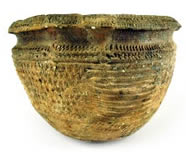School children had an unexpected treat on their visit to Avebury, when they got the chance to handle Neolithic objects fresh from the ground in which they had been buried for more than 4,000 years.


The objects – flints, bones and pottery - were discovered by Bob Davis, of Wessex Archaeology, who was working with the BT engineer updating a cable trench alongside the road, parallel to the two rows of giant stones which form the South (West Kennet) Avenue. Bob was there to record any significant finds uncovered during the maintenance work. While digging under the cable trench to the north end of the Avenue, Bob uncovered a small circular pit, roughly half a metre in diameter, containing cattle bones and fragments of pottery.
Similar pits had been discovered in the 1930s when Alexander Keiller carried out investigations between the stones of the Avenue and within the great henge itself. The function of these pits has remained a mystery. The deposits follow a similar pattern, with cattle bones and pottery sherds placed deliberately within the pits, suggesting that they may have been offerings to the gods.


The pottery in this pit, as in many others in the area, is of a type known as Mortlake pottery, between 5,400 – 4,500 years old.
The cattle bones are being sent for radiocarbon dating which will give useful information about this newly discovered pit.
The South (West Kennet) Avenue at Avebury is part of one of the greatest surviving concentrations of Neolithic and Bronze Age monuments in Western Europe. The Avebury archaeological landscape, together with Stonehenge, became a World Heritage Site in 1986.
The lucky children were from three local primary schools, taking part in an education project working with Wessex Archaeology and World Heritage Sites. By a stroke of good luck their visit coincided with Bob’s work.
